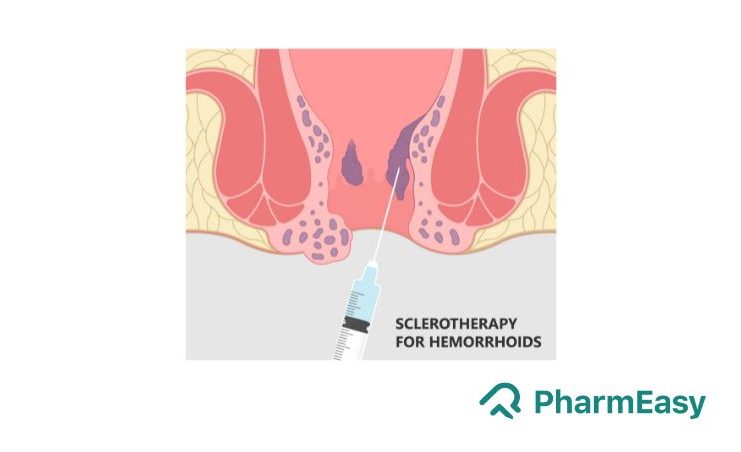Sclerotherapy for Piles: Treatment, Side Effects and Risks
By Dr. Mayuri Pandey +2 more

Get,

to manage your symptom
Get your,


4 Cr+ families
benefitted

OTP sent to 9988776655



You’ve successfully subscribed to receive
doctor-approved tips on
Whatsapp

Get ready to feel your best.

Hi There,
Download the PharmEasy App now!!


Register to Avail the Offer
Send OTPBy continuing, you agree with our Privacy Policy and Terms and Conditions

Hi There,
Sign up on PharmEasy now!!
Trusted by 4 crore+ families

OTP sent to 9988776655



You have unlocked 25% off on medicines




Code: NU25



By Dr. Mayuri Pandey +2 more
Table of Contents
Piles, also called haemorrhoids, are swellings in or around the anal region. Piles are the most common (nearly 40 million Indians) anorectal disease affecting adults irrespective of their age and sex. Among the wide range of treatment options for managing piles, a non-surgical modality is a sclerotherapy. The first sclerotherapy procedure dates back to the year 1928, done by Dr Dixon in the United States. This procedure is used for internal haemorrhoids arising due to the abnormal enlargement of anal tissues. Chemicals called sclerosing agents or sclerotherapy agents are injected into the veins using a needle to shrink the haemorrhoids.1-5
You should seek medical consultation if you notice these symptoms without delay. Depending upon the degree of severity, your doctor will decide on the need for sclerotherapy.7

Your doctor or proctologist will take a detailed history and thorough physical examination to confirm haemorrhoids. He may consider using a proctoscope, which is a short tube with a light on one end to view the tissues surrounding the anal region. If the diagnosis of internal haemorrhoids is confirmed, your physician may suggest the need for sclerotherapy.3
Your doctor will recommend a sclerotherapy procedure in the following situations: 7
Before sclerotherapy, you will be given anaesthesia to reduce the sensation of pain. As anaesthesia will induce a feeling of numbness, you should ensure some caretaker or someone from your family should accompany you. In this section, we will learn in brief about sclerotherapy
In simple terms sclerotherapy helps in making piles a fibrous tissue which doesn’t bleed and eventually falls off. However pls consult your proctologist for best treatment.
Dr. M.G. Kartheeka, MBBS, MD(Pediatrics)
Avoid sitting for long periods and change your sedentary lifestyle. Include moderate-intensity exercises like walking into your daily routine.
Surgery for piles is usually safe and secure. There might be some bleeding after the surgery due to swelling of tissues around anus which should gradually get better in a few days on its own.
Dr. Ashish Bajaj, M.B.B.S., M.D. in Clinical Pharmacology and Toxicology
Read More: 8 Best Home Remedies For Piles
Different treatment modalities, including non-surgical methods like sclerotherapy, have been used for decades for managing piles associated with bleeding or a high risk of bleeding. The sclerotherapy procedure involves injecting sclerosing agents into the veins surrounding the anal region or into the haemorrhoids. The benefits of this procedure should always be outweighed the associated risks, side effects and complications.
Sclerotherapy is a non-surgical procedure used to manage piles.1,2
Hepatitis, abdominal bloating and discomfort and acute respiratory syndrome are the complications of sclerotherapy.2
The side effects of sclerotherapy include extreme pain, ulcers and pus formation in the prostate gland. 2
No, sclerotherapy is recommended for the treatment of internal haemorrhoids only.1,2
Sclerotherapy is contraindicated in thrombosed haemorrhoids, inflammatory bowel disease, liver, kidney and heart-related diseases and allergies.2
Yes, sclerotherapy may be painful but your doctor will prescribe painkillers and give you anaesthesia to numb the site of surgery.
Disclaimer: The information provided here is for educational/awareness purposes only and is not intended to be a substitute for medical treatment by a healthcare professional and should not be relied upon to diagnose or treat any medical condition. The reader should consult a registered medical practitioner to determine the appropriateness of the information and before consuming any medication. PharmEasy does not provide any guarantee or warranty (express or implied) regarding the accuracy, adequacy, completeness, legality, reliability or usefulness of the information; and disclaims any liability arising thereof.
Links and product recommendations in the information provided here are advertisements of third-party products available on the website. PharmEasy does not make any representation on the accuracy or suitability of such products/services. Advertisements do not influence the editorial decisions or content. The information in this blog is subject to change without notice. The authors and administrators reserve the right to modify, add, or remove content without notification. It is your responsibility to review this disclaimer regularly for any changes.

Leave your comment...

View all comments(1)
My father took injection for piles can he continued his medicine for dibities bp